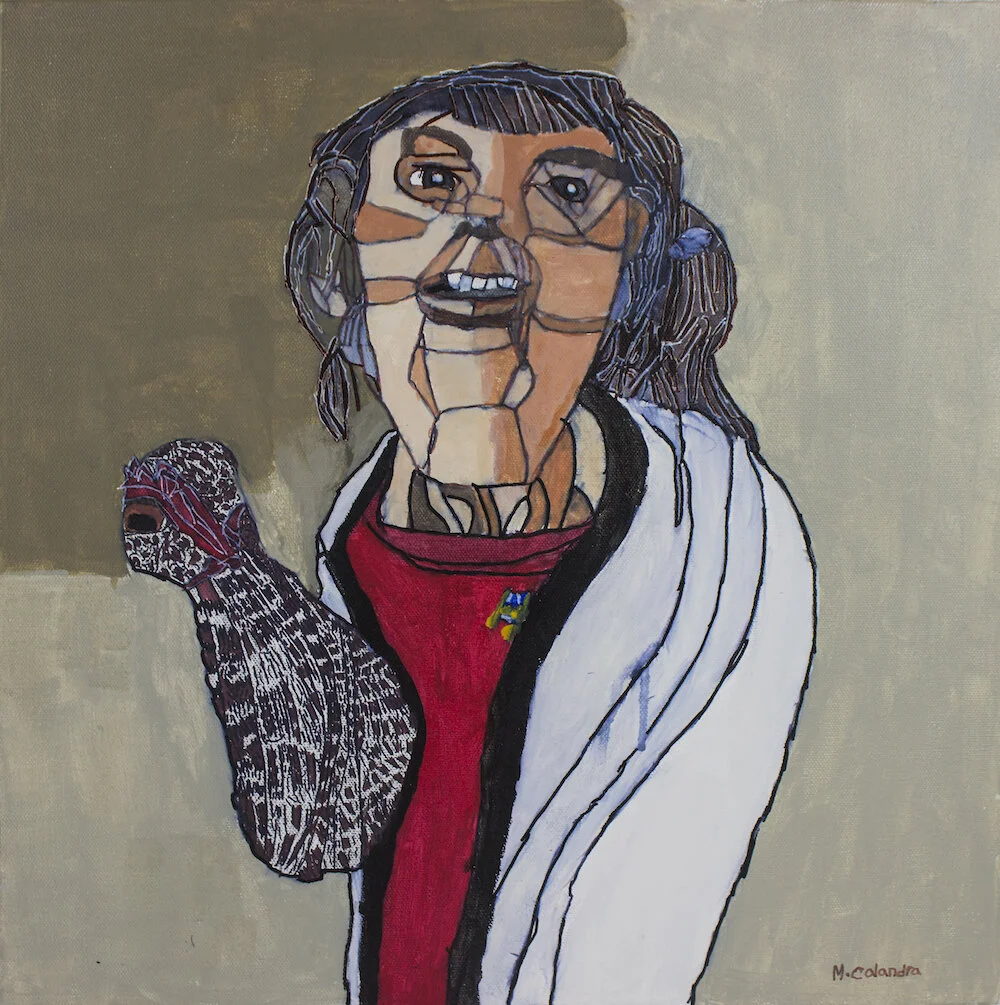Artist Feature / 07
Writer Jennifer Higgie explores the practices of Australian artists Mathew Calandra, Matthew Clarke and Lisa Reid.
In 2021, Matthew Clarke painted a portrait of a fellow artist and friend. Titled Del Kathryn Barton is a Good Listener, it was one of only 52 artworks out of 1,500 to be selected for the 2021 Archibald Prize. It’s clear why the life-size painting made the cut: its personality, bold colours and vibrant lines leap off the canvas. Clarke – whose work recalls the intense energy of expressionist painters such as Jean-Michel Basquiat and David Larwill – depicted the artist’s blue eyes as bright beacons of hope; she faintly smiles beneath her elaborate hairdo, which adorns her head like a trophy. The room she’s in is as lively as her blocky purple, green and yellow pyjama suit. It’s a picture that radiates joy and friendship – and it’s a welcome counterpoint to one of the toughest years the planet has experienced. That Del Barton has twice won the Archibald gives Clarke’s portrait a neat symmetry: the painter paints the painter.
Clarke met Del Barton on Instagram, where he avidly documents his work in progress. At the time of writing, in early August 2021, Clarke has just posted a photograph with his latest painting: Lost in Sydney with Matthew Clarke. (Many of his intriguing titles function like short stories). The artist portrays himself gazing directly out at us: his face is a blazing pink, his clothes green, purple and blue. He’s surrounded by the sunny exuberance of Sydney Harbour; the famous bridge arcs behind him like a crown. He gestures with his right hand; by his left, a giant, orange-crested parrot gazes out to sea. Despite the title, it’s a composition that seems less about the anxiety of getting lost than the excitement of discovering a city you don’t know.
Clarke describes himself as ‘an action-style painter’ who wants to express ‘my happiness to people’. Inspired by his daily life, travel, his friends, family and animals, his paintings, which seem to glow with an inner radiance, often recall intricate mosaics and stained-glass windows. Clarke has also painted inner-city murals and a Melbourne tram and created sculptures: recent ones include a flamboyant cat on its hind legs, that appears to be dancing a little jig and a house that seems to be morphing into a human: it has eyes like windows and has sprouted arms.
The work of Mathew Calandra also focuses on the human figure, and he too creates a range of intensely animated images via meticulous patterning. However, his palette is earthier and his use of line more delicate; as with a new portrait of the writer James Baldwin, he often builds a face from a web of meandering lines. While his work is deeply engaged with the contemporary moment, it also nods to expressionist artists from the past such as Egon Schiele and John Brack. Chicken and Lady (Emily), for example, is a portrait of a woman against a dusty, drought-like background. The deep red of her blouse vibrates under her pale blue wrap, animating the exotic, jewel-like chicken she holds close. She looks directly at us; her mouth is slightly open, as if she’s about to smile; her face is formed of a series of flat planes – she seems weathered and wise. In another beautiful untitled picture, a cluster of small white wildflowers, outlined in red, float above the ochre-and-blue landscape. Deep blue-green gum leaves shimmer with miniscule dots; small, brilliant red flowers beat at the heart of the image. It’s like an ode to the ever-shifting beauty of the natural world.
I wrote to Mathew and asked him what inspires him. His answer attests to the scope of his sources: ‘Friends, ancient Egypt, Harrison Ford, Nightmare on Elm Street, my Mum – she is so sweet and kind – my new cat Angel, also caramel slice. Also, old stories and myths like the Never-Ending Story and the ouroboros.’
A variety of characters – from her family to celebrities and sportsmen and women – also populates Lisa Reid’s imaginative world. Working across a range of media – from intricately detailed ceramics and atmospheric prints and paintings to economical drawings and an autobiographical digital animation – Reid finds inspiration in her environment, her family, photo albums and magazines. Whether employing a monochromatic palette or an explosion of colour, she moves fluently between macro and micro-observations: from the design of a man’s suit or a young girl’s jumper to the weave of a tennis net and the expressions on a dog’s face. Often working from photographs, some of her pictures are labour intensive and takes months to complete.
Reid’s talent for observation is acute. In her swift, unflinching drawings, she creates sparse, minutely detailed portraits, which bring the sitter to life: the hair on a man’s chest recalls the scales of fish; a girl has turned her head and her eyelashes flutter like a bird’s wing; a smiling woman sits on a rug and glances to the side, as if she’s glimpsed a friend. Many of her ceramic works echo Pop Art’s celebrations of mass culture. She’s conjured a series of marvellously realistic objects from clay: a glossy black zero Coke can with a straw, a box of battered fish and chips, a cash register – complete with notes and change – and a pair of fancy shoes.
Her paintings often focus on the pleasure she takes in her community, be it picnics, car journeys or playing sport – Reid speaks from experience, as she’s a gifted swimmer who has been a finalist in the Special Olympics.
Although they each approach their subjects with great originality, collectively, the skill and wit of Clark, Calandra and Reid’s wonderfully vivid work is an important contribution to the development of figurative art in Australia and internationally. Their discipline, enthusiasm and restless experimentation is a testament to the potential of the imagination to not only respond to the minutiae of our lives – but to delight in the infinite possibilities contained within a pencil, a pot of paint, a lump of clay, or a video camera.
Banner image (darkened and cropped): © Lisa Reid, Not titled, 2018, Gouache, greylead and colour pencil on paper, 56 x 76 cm.
1/ © Matthew Clarke with his artwork Del Kathryn Barton is a good listener, Acrylic on canvas, 184.5 x 121.5 cm. Courtesy of the artist.
2/ © Mathew Calandra, Chicken Lady (Emily), 2017, acrylic and pen on canvas, 45x45cm.
3/ © Lisa Reid, Serena Williams, 2015, pencil on paper, 38 x 28 cm. Courtesy of the artist and Arts Project Australia, Melbourne.
Jennifer Higgie is an Australian writer who lives in London. Her new book The Mirror and the Palette: 500 Years of Women’s Self-Portraits is published by Weidenfeld & Nicolson. She is currently working on a new book, a radio essay for the BBC about art and the spirit world, various scripts and essays. Jennifer was frieze magazine reviews editor from 1998-2003; co-editor with Jörg Heiser and then Dan Fox until 2017; frieze Editorial Director from 2017-19 and editor-at-large until 2021. She is the presenter of Bow Down, a podcast about women in art history; the author and illustrator of the children’s book There’s Not One; the editor of The Artist’s Joke; author of the novel Bedlam; and the writer of the feature film I Really Hate My Job.
—
Matthew Clarke (b 1986, Warrnambool) is enamoured with the vibrant world that surrounds him and paints his subjects with an unquestionable spontaneity and conviction. His works tell of an effervescent ecology bursting at the seams with eccentric and dynamic characters. In his recent exhibition ‘Bird Watch’, Clarke tuned his perceptive focus upon the menagerie of avian nomads, which flock, flutter and flit within and amongst his family’s rambling acreage. Each dazzling visual record presents a unique persona hatched from Clarke’s undeniable joie de vivre. Represented by Mossenson Galleries in Perth, his work is held in numerous public collections including Artbank, as well as private collections worldwide.
Mathew Calandra has an unmistakable and arresting linear style. Sharp, sinuous, awkward and dynamic, some have likened his line-work to that of Egon Schiele, the great symbolist-expressionist artist of the late nineteenth century. Like Schiele, with his hand, Calandra transforms the banalest subject matter into something of deep mystical beauty. He has exhibited in national and international exhibitions. He has undertaken residencies at the prestigious Cicada Press within UNSW Art & Design and Red Room Poetry. Represented by Studio A in Sydney, his work is held in numerous public collections including Artbank, as well as private collections worldwide.
Lisa Reid (b 1975, Melbourne) is an accomplished multidisciplinary artist working in ceramics, painting, drawing, printmaking and digital media. Often utilising preliminary workings of an image as a blueprint for her work, her attention to detail is apparent in her painting and drawing as well as her ceramic and digital media practice. Reid has worked and been represented by Arts Project Australia since 2002 and held her first solo exhibition in 2015, and she has shown in major exhibitions nationally and internationally. Her work is held in numerous public collections including the National Gallery of Australia and the National Gallery of Victoria, as well as private collections worldwide.





